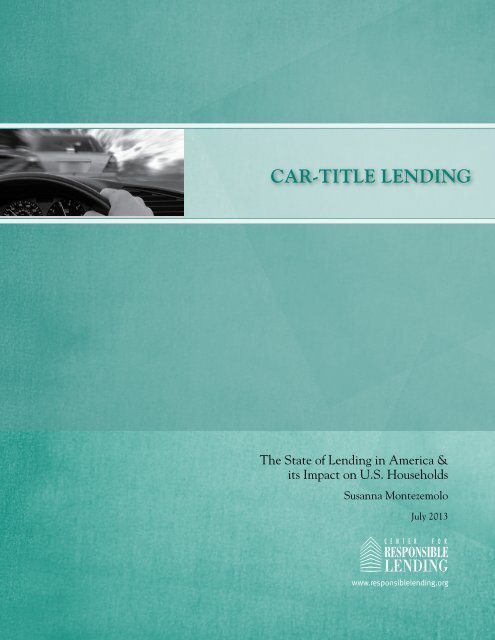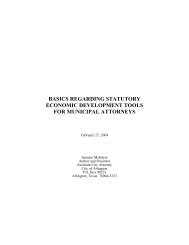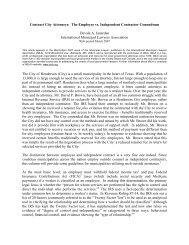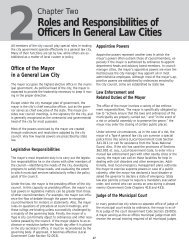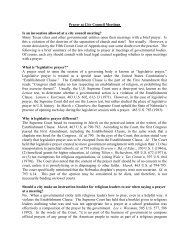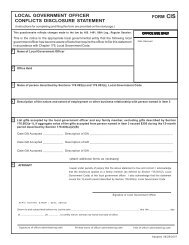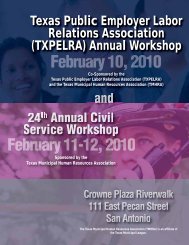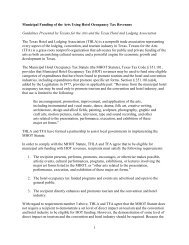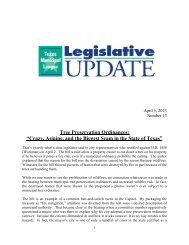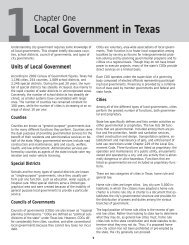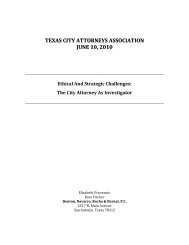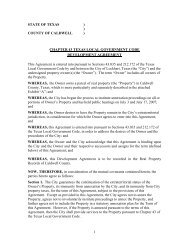Center for Responsible Lending Car Title Loans Report
Center for Responsible Lending Car Title Loans Report
Center for Responsible Lending Car Title Loans Report
Create successful ePaper yourself
Turn your PDF publications into a flip-book with our unique Google optimized e-Paper software.
CAR-TITLE LENDING ABUSES AND PREDATORY PRACTICES<strong>Car</strong>-title loans are expensive loans averaging more than $1,000 that are secured by the title to avehicle that the borrower owns free-and-clear. They are traditionally offered as payday-loan-likesingle-payment loans with one-month terms, which tend to be renewed multiple times like theirpayday counterparts. An emerging practice is a movement toward longer-term and still high-costinstallment products.The very structure of car-title loans leads to problems <strong>for</strong> consumers, including excessive repaymentfees and repossessions, as detailed below.Asset-Based <strong>Lending</strong>Asset-based lending generally refers to making loans without evaluating the borrower’s ability torepay the loan. Instead, lenders base the decision of whether and how much to lend on the valueof the collateral. A classic example of asset-based lending was subprime mortgage loans made in theheight of the mortgage bubble of the 2000s, when lenders often did not even ask <strong>for</strong> proof of borrowerincome. Borrowers who could not af<strong>for</strong>d their loans had no choice but to continually refinance theirloans based on the value of their homes or sell their houses to pay off the loans.1<strong>Car</strong>-title lenders similarly engage in asset-based lending. <strong>Car</strong>-title loans are based on the value of aborrower’s car that is owned free-and-clear, rather than the ability of the borrower to repay the loanand meet other obligations without re-borrowing. A typical car-title loan requires no credit check,2and lenders do not generally ask about monthly expenses or debts. Some do not ask about income3or require that the borrower have a bank account. Rather than properly underwriting the loans basedon a borrower’s income and obligations, lenders protect themselves from loan losses by lending onlya small percentage (about one-quarter) of the car’s consumer resale value (commonly known as “BlueBook” value) and repossessing the vehicle in the event of default.41 Federal banking regulators issued joint guidance against asset-based lending, which stated: “<strong>Loans</strong> to borrowers who do notdemonstrate the capacity to repay the loan, as structured, from sources other than the collateral pledged, are generally consideredunsafe and unsound” (OCC, FRB, FDIC, & OTS, 2001). Notably, these provisions applied to all types of bank-originated credit, notsimply mortgages.2 Martin & Adams (2012) state in their survey of all car-title lending stores in Albuquerque, NM, “Income requirements in the loanswere lenient to non-existent.” Certainly, these are how the loans are marketed. For example, <strong>Title</strong>Max—a leading national car-titleloan company—states on its website, “Your credit score doesn’t matter. <strong>Title</strong>Max can give you a title loan whether you have goodcredit, bad credit, or no credit. And your credit score isn’t affected by applying/obtaining a title loan with <strong>Title</strong>Max.” Elsewhere on thewebsite, it states: “You do not need good credit. <strong>Title</strong>Max does not check your credit or use your credit history in any way during theapproval process” (<strong>Title</strong>Max, 2013).3 For example, Zywicki (2010) states, “Lenders may [emphasis added] verify employment, income, and per<strong>for</strong>m a credit check, butthe practice is not uni<strong>for</strong>m. Most scrutiny focuses on the value of the car rather than the borrower.”4 Lenders sometimes state that they lend a higher percentage of the car’s value, but this is based off of the vehicle’s wholesale value(known as the “Black Book” value, which is similar to a dealer’s trade-in value). The Black Book value is lower than the Blue Book value.118The State of <strong>Lending</strong> in America and its Impact on U.S. Households
A title lending industry trade group, the American Association of <strong>Responsible</strong> Auto Lenders(AARAL), wrote in a 2011 comment letter to the Consumer Financial Protection Bureau (CFPB):“The loan we provide is secured by a first lien on the customer’s vehicle and the amount of the loan isbased on an appraisal of the value of the vehicle. By contrast, many other alternative financial serviceproviders make an unsecured loan primarily based on an evaluation of the consumer’s credit.”In a law review article, Martin & Adams (2012) write:With few exceptions, title lenders have no interest in whether the consumer borrowing themoney can af<strong>for</strong>d to pay back the loan or make the monthly interest payments. Ability torepay is not part of the underwriting process. [Emphasis added.] Nor need it be in order <strong>for</strong>lenders to collect their loan and then some. Since some lenders lend at 40% of value or less,they can rely on [repossessing and selling] the car if the borrower stops making the monthlypayments. These practices also explain why some title lenders sell used cars as well. Only in thiscontext would a lender loan $4,000 to someone who makes just $980 a month. By structuring aloan with $580 monthly payments from a person who makes less than $1,000 a month, a lendercan assure that he or she will end up with the payments <strong>for</strong> some period, and then the car.CRL and the Consumer Federation of America (CFA) analyzed litigation records made public duringlitigation against a large Delaware-based car-title lender.5 To our knowledge, this is the first-everanalysis of class action car-title data, and we present findings from this analysis throughout this Stateof <strong>Lending</strong> chapter. These data—which include records from 561 auto title borrowers—support Martin& Adams’s analysis. Figure 1 shows that the median loan-to-value ratio among borrowers in thesedata is 26%, while the median APR is 300%; that is to say, borrowers paid very high interest <strong>for</strong> loanswith significant excess collateral.Figure 1: Loan Characteristics from CFA/CRL <strong>Car</strong>-<strong>Title</strong> DataMedian Loan Size $845Median <strong>Car</strong> Value (Blue Book Value) $3,150Median Loan-to-Value Ratio 26%Median APR 300%Balloon Payments and Repeat BorrowingMany car-title loans combine balloon payments with a short (30-day) loan term, requiring theborrower to repay the full principal plus a substantial fee in just one month. Most borrowers cannotrepay the full amount due (principal plus interest) in one payment after just a month and still beable to pay their other expenses. As a result, they end up in a cycle of debt, taking out one loan afteranother in an ef<strong>for</strong>t to stay financially afloat; a loan that is advertised as short-term ends up creating along-term debt treadmill.5 Records were made available to CRL and CFA by Robert F. Salvin, Esq., Community Justice Project, made public through Salvatico v.<strong>Car</strong>bucks of Delaware, Inc. For additional in<strong>for</strong>mation about the data and analysis, see Fox, Feltner, Davis, & King (2013).<strong>Center</strong> <strong>for</strong> <strong>Responsible</strong> <strong>Lending</strong> 119
<strong>Car</strong>-title lenders exploit the mistaken perception that these loans are short-term by sometimes offeringthe first single balloon payment loan <strong>for</strong> “free” or at a reduced rate,6 knowing that borrowers willbe hard-pressed to pay back even only the principal borrowed in a month. These lenders lure borrowersin with the prospect of a “free” loan but enjoy significant fees after borrowers take out additionalloans in rapid succession. The President of <strong>Title</strong>Max, one of the largest car-title lending companieswith stores in multiple states, highlighted the cycle of debt in a deposition: “Customer loans aretypically renewed at the end of each month and thereby generate significant additional interestpayments” (Robinson III, 2009). State data support the existence of a cycle of debt as well. Forexample, in 2010—the latest year reported—over 90% of loans in Tennessee were renewed, and only12% of loans taken out that year were paid in full as of the end of the year (Tennessee DFI, 2012).Threat of RepossessionAs detailed in the following section, most car-title borrowers are low-income consumers who relyon their cars to commute to and from work. Repossession poses a real threat to employment andcauses additional fees to be added to the balance of the loan. Paying back the loan is the top financialpriority of borrowers, as the consequences of not doing so can be immediate and severe: Lenders useGPS devices to locate the car <strong>for</strong> repossession (Martin & Adams, 2012). Some even place a trackingdevice in the car that allows them to turn off the engine remotely.7 Repossession is not an infrequentoccurrence; <strong>for</strong> example, fully 60% of 2008 New Mexico car-title borrowers lost their car that yearto repossession.6 For example, according to the latest New Mexico car-title regulator report, the APRs on loans made in 2011 ranged from 0% to717%, indicating that some borrowers received a “free” first loan (New Mexico Financial Institutions Division, 2012).7 For example, according a CNN article, “A company based in Arizona said they have GPS systems installed on the cars so they cantrack the cars and shut them off remotely if they don’t receive payment on time” (Neiger, 2008).120The State of <strong>Lending</strong> in America and its Impact on U.S. Households
IMPACT ON U.S. HOUSEHOLDS<strong>Car</strong>-title borrowers generally have low or moderate incomes. Regulators in Illinois (Veritec, 2013)and New Mexico (New Mexico Financial Institutions Division, 2010) report that car-title borrowersin their states have average gross incomes of under $25,000 ($24,531 and $24,493, respectively).Zywicki (2010) found that about half of all car-title borrowers are unbanked, lacking access to bothmainstream and subprime credit.Income Impact and Loan ChurningThe combination of short-term balloon payments and minimal underwriting is particularly harmfulto borrowers taking out traditional 30-day car-title loans. Figure 2 highlights that borrowers earninga typical income of $25,000 per year cannot af<strong>for</strong>d to repay the average loan amount of $1,042—even a “free” loan with no fee—in a one-month loan term. If they did, they would not have enoughmoney left over <strong>for</strong> basic living expenses. To stay afloat financially, they need to extend the loan byre-borrowing the principal and paying the fee multiple times in an expensive cycle of loan churn.Figure 2: A 30-Day <strong>Car</strong>-<strong>Title</strong> Loan Results in a Debt Trap, Even with No FeeCost of a 30-Day <strong>Car</strong>-<strong>Title</strong> Loan <strong>for</strong> a Borrower Earning $25,000/Year in Gross Income$0 per $100 fee $25 per $100 fee(“free” loan, 0% APR)(300% APR)30-Day IncomeBe<strong>for</strong>e-tax income $2,083 $2,083Income taxes paid or (received, such as through theEarned Income Tax Credit) ($16) ($16)After-tax income $2,099 $2,099Social Security & pension payments $102 $102Net one-month income $1,997 $1,997<strong>Car</strong>-<strong>Title</strong> Loan CostFee due on average car-title loan of $1,042 $0 $261Total payment due on average $1,042 car-title loan $1,042 $1,303Amount remaining to cover all other expenses $955 $69430-Day Essential ExpendituresFood $357 $357Housing $977 $977Transportation (incl. insurance, gas, maintenance) $389 $389Heath care $221 $221Total essential expenditures $1,942 $1,942Funds remaining (or deficit) after payingauto title loan and essential expenditures ($987) ($1,248)Source: 2011 Consumer Expenditure Survey, Bureau of Labor Statistics, <strong>for</strong> households earning $20,000–$29,999 annually.<strong>Center</strong> <strong>for</strong> <strong>Responsible</strong> <strong>Lending</strong> 121
BORROWER STORIESWhether structuredas single-payment30-day loans that requiremultiple renewalsor as longer-term,high-cost installmentloans, car-title loanscreate a long-termcycle of debt. Theseborrowers highlightthe long-term costof these loans:Jeffrey Simmons, 56, ofGlendale, Arizona, took out a$2,000 title loan with 156% APRto pay <strong>for</strong> repairs after his carbroke down so he could travel tohis dialysis appointments threetimes a week. Living off of a fixedincome of $1,300 in monthlydisability payments, he paid onlyinterest on the loan <strong>for</strong> the firstfive months. When the balancewas due in the sixth month, herefinanced. Of his current monthly$308 car-title payment, only $28goes to principal. His car continuesto break down, and he takes abus to his dialysis appointments.Simmons advises, “Try to stayaway from them. You will neverpay that stuff back” (Brodeskyand O’Dell, 2013).James Haga of Marion, Virginiatook out a $1,600 300% APR titleloan on his truck. Ultimately, thelender repossessed his truck—worth $13,000—after havingcollected $4,500 (nearly threetimes the amount borrowed) inpayments (Kirchhoff, 2006).After repaying the principal due on the “free” loan, a typicalborrower has $955 remaining to pay $1,942 in essential expenditures,leaving a deficit of $987. The situation is worse <strong>for</strong>borrowers who pay the fee of $261,8 who end up with a deficitof $1,248. Many borrowers have other expenses not includedin the chart above—such as child care, clothing, other debtobligations, and the like—and face even greater difficulty inrepaying the loan.<strong>Car</strong>-title loans are structured to be unaf<strong>for</strong>dable. The onlyway most borrowers can meet the obligations of the 30-dayballoon payment while meeting their other monthly expensesis either to pay only the fee and extend the loan or to take outa new loan shortly after repaying the old one. Many borrowersremain indebted until they default or receive an atypical cashinfusion—such as a tax refund—that allows them to finally payoff the balance.<strong>Title</strong>Max data highlight this cycle of repeat borrowing, with a30-day loan being “typically renewed eight (8) times,” accordingto a deposition of the <strong>for</strong>mer CEO (Robinson III, 2009).Nine monthly loans per year (one loan plus eight renewals)puts the typical borrower in expensive, high-cost auto titledebt three-quarters of the year. Figure 3 highlights the averagecost of taking nine loans per year <strong>for</strong> the average loan sizeof $1,042.9Borrowers who take out the typical nine title loans in a yearpay back over three times the amount borrowed: $3,391 inpayments <strong>for</strong> a $1,042 loan. This is the case even thoughthey use a car typically worth more than $4,000—wellover three times the loan amount—<strong>for</strong> collateral.Figure 3: Total Borrower Cost of a Typical 30-Day <strong>Car</strong>-<strong>Title</strong> LoanAverage principal borrowed (see Appendix 1) $1,042Fee <strong>for</strong> first loan ($1,042*25%) $2618 additional renewal fees ($261*8) $2,088Total fees paid $2,349Total amount paid in principal and fees <strong>for</strong> a$1,042 loan $3,391Average car value * $4,008* Average car value assumes a 26% loan-to-value ratio (the median in the CRL/CFA data set).8 Based on the typical fee of $25/$100 borrowed.9 See Appendix 1 <strong>for</strong> the average loan size calculation.122The State of <strong>Lending</strong> in America and its Impact on U.S. Households
BORROWER STORIESAfter his daughter returned fromserving in Iraq and asked <strong>for</strong>financial help to relocate herfamily, Preston White, 63, tookout a title loan on his pickup truckfrom a store in Killeen, Texas. The30-day, $4,000 loan carried a 375%APR. White had already spent hislife savings on paying <strong>for</strong> treatment<strong>for</strong> his wife’s pancreaticcancer and soon realized that hisfixed income left him only enoughmoney to cover the fees, not theprincipal. He recognized the cycleof debt: “In four months, I couldhave paid more than what Iwent to the store <strong>for</strong> in the firstplace, and still owe the originalloan amount,” he said. “Neverin my wildest imagination did Ithink that such a loan productcould even exist. You assume thesystem will have usury laws andprotect you from such things. . . .Everybody’s got to make a profit,but there should be no place <strong>for</strong>usury in the 21st century.” Hewas ultimately able to retire thedebt by taking out a loan at16% APR through a credit union(Gogoi, 2010).Alicia and Clinton Lummusof Conyers, Georgia, took out a$525 car-title loan after injuries<strong>for</strong>ced them both to stop working.Over eight months, they made paymentstotaling $1,056—more thantwice the amount borrowed—butultimately fell behind on payments.The lender repossessed the vehicle,worth $14,000—and was able tokeep any excess money from thesale of the vehicle, since Georgialaw allows the lender to do so(Kirchhoff, 2006).CRL and CFA litigation data analysis provides furtherevidence that a car-title loan typically becomes a long-termcycle of debt.10 The average borrower was indebted <strong>for</strong> sixmonths. Around one in six borrowers (16%) was in continuousdebt <strong>for</strong> at least one year. Figure 4 highlights how muchborrowers paid in fees as a percentage of the amount that theyborrowed. 96% paid at least as much in fees as they receivedin principal; 40% paid at least twice as much in fees as theyreceived in principal; 15% paid at least three times as much;and 6% paid at least four times as much.Figure 4: Fees Paid by <strong>Car</strong>-<strong>Title</strong> Borrowers as a Percentage ofLoan Amount100% to 199%56%RepossessionLess than 100%4%Over 400%6%Source: CRL/CFA proprietary data set on file with CRL.300% to 399%9%200% to 299%25%The threat of repossession of the vehicle that serves ascollateral <strong>for</strong> a loan is a key incentive <strong>for</strong> borrowers topay off their loans. According to a report from the NationalConsumer Law <strong>Center</strong>, every state allows lenders torepossess vehicles without a court order, and most of theserepossessions are carried out by unlicensed individuals.These “self-help” repossessions can lead to bodily injury,trauma, or even death <strong>for</strong> the borrower, which “shows presentflaws in the present system <strong>for</strong> automobile repossessions”stemming from the lack of basic legal protections af<strong>for</strong>dedto auto owners (Van Alst & Jurgens, 2010).10 For more in<strong>for</strong>mation on these data, see footnote 5.<strong>Center</strong> <strong>for</strong> <strong>Responsible</strong> <strong>Lending</strong> 123
BORROWER STORIESShanell White of Elk Grove,Cali<strong>for</strong>nia, needed money topay <strong>for</strong> rent after her expensesincreased when she began tocare <strong>for</strong> her niece. She took outa $3,900 installment title loanusing her car—worth $12,000—as collateral. After having paidnearly $10,500 over three years,she was told she still owed thefull principal that she had borrowed.The lender repossessedand sold the car yet still sent hera bill <strong>for</strong> the loan after. “To me,it’s just modern-day loan sharking.People are being takenadvantage of,” she concluded(Said, 2013).Sean received a $1,500 car-titleloan, which he renewed over40 times—paying over $11,500 ininterest—be<strong>for</strong>e receiving helpfrom family to pay off the principal.He said, “I was too embarrassedto ask my parents <strong>for</strong> theinitial loan money, [but] endedup borrowing money fromthem to make some of thepayments and ultimatelyhad to ask them to pay off thewhole loan, after losing tonsof money along the way”(Martin & Adams, 2012).<strong>Car</strong>-title lenders claim that they repossess a relatively smallnumber of vehicles compared with the number of loans made.However, the more relevant statistic is the number of repossessionsrelative to the number of borrowers, since most 30-daycar-title borrowers take out many loans. In our litigation dataset, one in six borrowers (17%) incurred a repossession fee,typically $350–$400, which averaged half of the borrower’soutstanding balance.Martin & Adams (2012) found even higher repossessionrates in New Mexico between 2004 and 2008. Over this time,annual repossession rates ranged from 20% to 71%, dependingon the year that the loans were made. Some of these borrowersultimately paid back the loan (with substantial additional repossessionand other fees). However, as shown in Figure 5, therates of vehicle loss increased substantially from 2004, whenthe rate was 15%, to 2008, when 60% of borrowers permanentlylost their vehicles. This suggests that more borrowersgot into trouble as they were unable to get out of their loans.Figure 5: New Mexico <strong>Car</strong>-<strong>Title</strong> Repossession and Vehicle Loss Ratesby CustomerYear 2004 2005 2006 2007 2008Repossession Rateby Customer 28.7% 20.2% 53.1% 47.5% 71.2%Vehicle Loss Rateby Customer 14.6% 13.0% 41.0% 37.0% 60.1%Source: Martin & Adams, 2012Repossession and other fees are added to a borrower’s runningbalance. As a result, despite the low loan-to-value ratio ofthe initial loan, nearly all proceeds of the repossession sale godirectly to the lender.124The State of <strong>Lending</strong> in America and its Impact on U.S. Households
MARKET AND INDUSTRY OVERVIEWMarket SizeAs highlighted in Appendix 2, 30 states—including the District of Columbia (DC)—do not have anoticeable presence of high-cost car-title lenders. More than half (53%) of American adults live inareas where these loans are not offered.Twenty-one states have a significant presence of car-title lending. <strong>Car</strong>-title lenders in thesestates originate an estimated 2.0 million car-title loans each year worth $1.9 billion in annualloan dollar volume, not including churn.11 We estimate that borrowers pay $4.3 billion in feesalone on these loans.In addition, the Military <strong>Lending</strong> Act of 2006 (MLA) put in place protections from abusive lendingpractices <strong>for</strong> active-duty service members and their families. These protections include setting a36% maximum annual interest rate <strong>for</strong> certain types of consumer credit and banning the use of anautomobile title as security <strong>for</strong> a consumer credit loan. As a result, car-title loans cannot legally bemade to active-duty service members or their dependents regardless of where they live. The MLA wasenacted after the Defense Department grew concerned about active-duty service members becomingdeeply indebted to high-cost lenders, including title lenders, which put their security clearances andtheir financial well-being at risk (DOD, 2006).Types of <strong>Loans</strong>30-Day Balloon <strong>Loans</strong>30-day car-title loans are still the dominant market product, and are structured similarly to paydayloans. Figure 6 highlights some similarities between these loans. Lenders market both as short-term:one pay period (typically two weeks) <strong>for</strong> a payday loan, and one month <strong>for</strong> a title loan. Lenders donot engage in underwriting <strong>for</strong> either product. As a result, borrowers repeatedly take out loansbecause they cannot af<strong>for</strong>d to pay off the loan and cover their living expenses. Both types ofloans carry very high costs, typically triple-digit annual interest rates.11 For our estimates on loan volume and fees paid, see Appendix 3. For in<strong>for</strong>mation on methodology, see Appendix 4. Note thatthese estimates are updated from CRL’s publication from earlier this year, “Driven to Disaster” (Fox, Feltner, Davis, & King, 2013). Thisis because since publication of “Driven to Disaster,” several state car-title loan regulators have issued updated regulatory reports thathave allowed us to make new estimates.<strong>Center</strong> <strong>for</strong> <strong>Responsible</strong> <strong>Lending</strong> 125
Figure 6: Similarities between Payday and 30-Day Balloon Payment <strong>Car</strong>-<strong>Title</strong> <strong>Loans</strong>Features Payday <strong>Loans</strong> *30-Day Balloon Payment<strong>Car</strong>-<strong>Title</strong> <strong>Loans</strong>Typical Loan Size $350 $1,042Fee Charged $15 per $100 borrowed $25 per $100 borrowedUnderwriting <strong>for</strong> Af<strong>for</strong>dability None NoneTypical Loan Term 14 days, but often renewed 30 days, but often renewedTypical APR 322% 300%CollateralPost-dated check or electronicbank account access<strong>Title</strong> to vehicleTypical Number of Renewals 9 8* Data on payday loans from CFPB (2013).Longer-Term Installment <strong>Loans</strong>Despite the prevalence of 30-day balloon car-title loans, high-cost installment title loans are increasinglycommon. Installment car-title loans are offered in Texas, Illinois, New Mexico, and Cali<strong>for</strong>nia.Borrowers pay off these amortizing installment products over a period of months or sometimes years.Their triple-digit annual interest rates mean that over the course of the loan, they per<strong>for</strong>m similarlyto a 30-day balloon loan that is refinanced multiple times. That is, installment loan borrowers paymore in interest than they receive in principal. Two examples are highlighted in figure 7: The CashStore, a Texas-based car-title lender, charges 577% APR <strong>for</strong> a five-month installment car-title loanin which borrowers pay $1,700 to borrow just $1,000 (Cashstore.com, 2013). In Illinois, on averageborrowers paid $2,030 in interest alone <strong>for</strong> an $893 loan, with an average loan term of over a year(392 days) and an APR of 212% (Veritec, 2013).Figure 7: Installment <strong>Car</strong>-<strong>Title</strong> Borrowers Pay More in Fees Alone Than They Receive in PrincipalThe Cash Store(Texas <strong>Car</strong>-<strong>Title</strong> Lender)Illinois average figuresfrom regulator reportPrincipal Borrowed Interest Paid Total Paid Loan term APR$1,000 $1,700 $2,700 154 days 577%$893 $2,030 $2,923 392 days 212%126The State of <strong>Lending</strong> in America and its Impact on U.S. Households
LEGISLATION AND REGULATION<strong>Car</strong>-title lending, like payday lending, began to surface in the 1990s when states exempted thecar-title industry from consumer usury limits of around 36% APR. States without car-title lendinggenerally simply have not acted to exempt title lenders from these usury limits. It is important to notethat although many lenders argue that they cannot make loans at less than triple-digit rates, otherscontinue to make small loans within these limits, with or without a car-title as collateral. For example,some banks and credit unions offer refinancing on car loans that include cash out to the owner.In addition, the FDIC’s two-year Small-Dollar Loan Pilot Program—which featured unsecured loansof $2,500 or less at a maximum 36% APR <strong>for</strong> a loan term of at least 90 days—resulted in 34,400 loanswith a principal balance of $40.2 million (Miller, Burhouse, Reynolds, & Sampson, 2010).Of the 21 states with car-title lending, 17 have explicitly authorized car-title lending at triple-digitAPRs or have set no rate cap. Over half of these 17 states have no limits on the interest or fees thatlenders may charge.Four states (Cali<strong>for</strong>nia, Kansas, Louisiana, and South <strong>Car</strong>olina) have not explicitly authorized cartitlelending, but lenders exploit loopholes or definitional weaknesses in state law to make these loansat triple-digit annual rates to borrowers:• <strong>Car</strong>-title lenders in Kansas avoid a 36% annual rate cap that applies to closed-end small loans bycalling the loans open-ended (Plunkett & Hurtado, 2011).• In South <strong>Car</strong>olina, car-title loans are typically made <strong>for</strong> at least $601 to avoid the small loan ratecap that covers smaller loans. Similarly, in Cali<strong>for</strong>nia, car-title loans are made <strong>for</strong> over $2,500 toavoid state laws that apply to smaller loan amounts.• Although Louisiana specifically rejected an attempt to authorize car-title lending, car-titlelenders operate under the terms of the Louisiana Consumer Credit Law by making title loans<strong>for</strong> more than $350 <strong>for</strong> a loan term of over two months.Even in states that explicitly allow car-title loans at triple-digit APRs, lenders sometimes chargehigher rates through a loophole or another statute not intended <strong>for</strong> their product. For example, eventhough the Missouri <strong>Title</strong> Loan Law allows unlimited interest rate charges, it requires a 10% principalreduction upon the third refinancing. To avoid this modest principal reduction requirement, lendersoffer car-title loans under the state’s small loan law (Hathaway, 2010).Several states also authorize installment car-title loans. Cali<strong>for</strong>nia, <strong>for</strong> example, authorizes consumerinstallment loans up to $5,000, whether unsecured or secured by real or personal property, includingliens on motor vehicles.12 Likewise, New Mexico allows <strong>for</strong> car-title installment loans.13 Illinoisexplicitly provides <strong>for</strong> “title-secured loans” in amounts up to $40,000.14In Texas, car-title installment loans are explicitly authorized.15 However, most title lenders inTexas, whether offering traditional car-title loans or car-title installment loans, do so under theCredit Services Organization law.16 Under this scheme, lenders position themselves as credit servicesorganization (CSOs) and broker loans on behalf of borrowers. This allows title lenders to charge themaximum interest rate allowed on the underlying loan plus an addition brokerage fee.12 Cali<strong>for</strong>nia Finance Lender Law, Cal. Fin. Code § 2220313 New Mexico Bank Installment Act, N.M. Stat. Ann. § 58-1-1, et seq.14 Illinois Consumer Installment Loan Act, 205 Ill. Comp. Stat. §§ 670/15(a)15 Tex. Fin. Code § 342.001, et seq.16 Tex. Fin. Code §393.602<strong>Center</strong> <strong>for</strong> <strong>Responsible</strong> <strong>Lending</strong> 127
POLICY RECOMMENDATIONS• The Consumer Financial Protection Bureau should promulgate regulations that rein in unfair,abusive, and deceptive car-title loan terms. Lenders should be required to evaluate a borrower’sability to repay the loan and meet other expenses without taking out a subsequent loan.• Many states with car-title lending have caps of around 36% on the annual interest rates thatmay be charged <strong>for</strong> small loans. States that have granted exemptions to these interest rate limitsto car-title lenders should revoke them, and states that have not should refrain from doing so.• States that continue to authorize car-title lending should require that loans be structured asinstallment products with amortizing equal monthly payments, full consideration of the borrower’sability to repay the loan and af<strong>for</strong>d other expenses, and reasonable rate limitations.• State policymakers and regulators must remain vigilant in en<strong>for</strong>cing or strengthening theirstate lending laws. They should rein in evasion from car-title lenders, who sometimes seek totake advantage of narrow definitions, loopholes, or gaps in laws to charge higher rates than thelegislature intended.• In the event of a default, borrowers must be provided important consumer protections, includingnotice prior to repossession or sale of the vehicle, a right to redeem the vehicle, and a ban ondeficiency balances (in which the borrower owes fees to the lender if the sale of their car does notcover the outstanding debt owed). Sale of repossessed vehicles should be commercially reasonablewith any surplus returned to the borrower.• In addition to substantive protections, the Consumer Financial Protection Bureau and states withcar-title lending should collect and make public more data on title lending to allow <strong>for</strong> policyanalysis on the borrower impact and various public policies in place to regulate the practice.128The State of <strong>Lending</strong> in America and its Impact on U.S. Households
ReferencesAmerican Association of <strong>Responsible</strong> Auto Lenders (AARAL). (2011). Comment letter to Consumer Financial ProtectionBureau (CFPB Docket No. CFPB-HQ-2011-2).Brodesky, J. and O’Dell, R. (2013). “<strong>Title</strong> loans hurt poor, critics say: <strong>Loans</strong> with cars as collateral replacing paydayborrowing.” Arizona Republic. Available at http://bit.ly/12RlSx9 (viewed 5/30/13).Cashstore.com. (2013). “Texas title loans and installment title loans.” Available at http://bit.ly/13iINVP (viewed 6/13/13).Consumer Financial Protection Bureau (CFPB). (2013). “Payday loans and deposit advance products: A white paper ofinitial data findings.” Available at http://1.usa.gov/1aX9ley.Department of Defense (DOD). (2006). “<strong>Report</strong> on predatory lending practices directed at members of the armed <strong>for</strong>ces andtheir dependents.” Available at http://1.usa.gov/Vc3aMP.Fox, J.A., Feltner, T., Davis, D., and King, U. (2013). “Driven to disaster: <strong>Car</strong>-title lending and its impact on consumers.”<strong>Center</strong> <strong>for</strong> <strong>Responsible</strong> <strong>Lending</strong> and Consumer Federation of America. Available at http://bit.ly/17GAEeu.Forsyth, J. (2012). “More than two-thirds in U.S. live paycheck-to-paycheck: Study.” Reuters. Available athttp://reut.rs/RC6DHZ.Gogoi, P. (2010). “Costly cash: How a retiree wound up with a 375% loan.” Daily Finance. Available at http://aol.it/16TVtof(viewed 5/24/13).Hathaway, M. (2010). “Missouri lenders find ways to avoid title-loan regulations.” St. Louis Post-Dispatch. Available athttp://bit.ly/TuRVj8 (viewed 7/10/13).Kirchhoff, S. (2006). “Some consumers run into big problems with auto title lending.” USA Today. Available athttp://usat.ly/124EbDR (viewed 5/25/13).Martin, N. & Adams, O. (2012). “Grand theft auto: Repossession and demographic realities in title lending.” Missouri LawReview. Available at http://bit.ly/Zl2wSX.Miller, R., Surbhouse, S., Reynolds, L., and Sampson, A.G. (2010). “A template <strong>for</strong> success: The FDIC’s small-dollar loanpilot program.” FDIC Quarterly. Available at: http://1.usa.gov/126UV6l.Neiger, C. (2008). “Why car-title loans are a bad idea.” CNN. Available at http://bit.ly/12RlK0y (viewed 5/30/13).New Mexico Department of Financial Institutions (DFI). (2010). “Summary of title loans, calendar year 2009.”New Mexico Department of Financial Institutions (DFI). (2012). “Annual report regarding installment loan products withAPR greater than 175%.”Office of the Comptroller of the Currency, Board of Governors of the Federal Reserve System, Federal Deposit InsuranceCorporation, and Office of Thrift Supervision (OCC, FRB, FDIC, & OTS). (2001). “Extended guidance <strong>for</strong> subprimelending programs.” Available at http://1.usa.gov/XESVVc.Plunkett, L.A. & Hurtado, A.L. (2011). “Small-dollar loans, big problems: How states protect consumers from abuses andhow the federal government can help.” Suffolk University Law Review. Available at http://bit.ly/Vjpe8y.Robinson III, J.W. (2009). Affidavit of John W. Robinson III, President of <strong>Title</strong>Max Holdings LLC, U.S. Bankruptcy Court<strong>for</strong> the Southern District of Georgia, Savannah Division.Said, <strong>Car</strong>olyn. (2013). “‘<strong>Car</strong>-title loans’ a road to deep debt: Legislators weight capping high-interest ‘car-title loans.’”San Francisco Chronicle. Available at http://bit.ly/ZgEx6D (viewed 5/30/13).Tennessee Department of Financial Institutions (Tennessee DFI). (2012). “2012 report on the title pledge industry.”Texas Office of the Consumer Credit Commissioner (Texas OCCC). (2013). “Credit access bureau (CAB) annual datareport, CY 2012 (Rev. 05/06/2013).” Available at http://bit.ly/10AHCxt.<strong>Title</strong>Max. (2012). Third-quarter 2012 10-K filing with the Securities and Exchange Commission. Available athttp://1.usa.gov/UJ6h0O.<strong>Title</strong>Max. (2013). Frequently Asked Questions. Available at http://www.titlemax.biz/faqs/ (viewed 1/5/13).<strong>Center</strong> <strong>for</strong> <strong>Responsible</strong> <strong>Lending</strong> 129
Van Alst, J. and Jurgens, R. (2010). “Repo madness: How automobile repossessions endanger owners, agents and the public.”National Consumer Law <strong>Center</strong>. Available at http://bit.ly/Zf0jYd.Veritec. (2010). “<strong>Report</strong> on car-title lending activity from Nov. 2009-Dec. 2010.” Prepared <strong>for</strong> the State of IllinoisDepartment of Financial and Professional Regulation.Veritec. (2013). “Illinois trends report all consumer loan products through September 2012.” Prepared <strong>for</strong> the State ofIllinois Department of Financial and Professional Regulation. Available at http://bit.ly/Zeby5O.Virginia Bureau of Financial Institutions. (2012). “The 2011 report of the bureau of financial institutions: Paydaylender licensees, check cashers, motor vehicle title lender licensees operating in Virginia at the close of businessDecember 31, 2011.”Zywicki, Todd. (2010). “Consumer use and government regulation of title pledge lending.” Loyola Consumer Law Review.Available at http://bit.ly/Utqne8.130The State of <strong>Lending</strong> in America and its Impact on U.S. Households
Appendix 1: Weighted Average <strong>Car</strong>-<strong>Title</strong> Loan AmountAverage <strong>Car</strong>-<strong>Title</strong>Loan AmountNumber of<strong>Car</strong>-<strong>Title</strong> StoresIllinois $893 437New Mexico $959 194Texas1 $1,089 2,258Virginia $976 378Total 3,267Weighted Average $1,0421 Texas provided data on both single-payment and installment car-title loans. To determine the average loan amount, we calculatedthe total loan volume (including both types of loans) and divided by the total number of loans (including both types of loans). Inaddition, Texas reported a total of 2,094 single-payment car-title lenders and 986 installment car-title lenders. Because we do notknow how many stores make both types of loans, we included only the number of single-payment lenders. The number of stores inTexas may there<strong>for</strong>e be higher.Appendix 2: Presence of <strong>Car</strong>-<strong>Title</strong> <strong>Lending</strong> by State21 States with a Significant Presence of <strong>Car</strong>-<strong>Title</strong><strong>Lending</strong> (at least $4 Million/Year Loan Volume,not including refinances)Alabama (defined as a pawn transaction)ArizonaCali<strong>for</strong>nia (>$2,500)DelawareGeorgia (defined as a pawn transaction)Kansas (open-ended)Louisiana (>$350, loan term of over two months)IdahoIllinoisMississippiMissouriNevadaNew HampshireNew MexicoSouth <strong>Car</strong>olina (>$600)South DakotaTennesseeTexasUtahVirginiaWisconsin30 States (including DC) without aSignificant Presence of High-Cost<strong>Car</strong>-<strong>Title</strong> <strong>Lending</strong>AlaskaArkansasColoradoConnecticutDistrict of ColumbiaFloridaHawaiiIndianaIowaKentuckyMaineMarylandMassachusettsMichiganMinnesotaMontanaNebraskaNew JerseyNew YorkNorth <strong>Car</strong>olinaNorth DakotaOhioOklahomaOregonPennsylvaniaRhode IslandVermontWashingtonWest VirginiaWyoming<strong>Center</strong> <strong>for</strong> <strong>Responsible</strong> <strong>Lending</strong> 131
Appendix 3: Estimate of State and National <strong>Car</strong>-<strong>Title</strong> Loan Dollar Volume, Excluding RefinancesState # Stores Total # <strong>Loans</strong> Total Loan VolumeAlabama 672 152,544 $158,950,848Arizona 479 108,733 $113,299,786Cali<strong>for</strong>nia 281 63,787 $66,466,054Delaware 56 12,712 $13,245,904Georgia 375 85,125 $88,700,250Idaho 108 24,516 $25,545,672Illinois *1 437 59,673 $53,314,357Kansas 86 19,522 $20,341,924Louisiana 180 40,860 $42,576,120Mississippi 360 81,720 $85,152,240Missouri 343 77,861 $81,131,162Nevada 197 44,719 $46,597,198New Hampshire 43 9,761 $10,170,962New Mexico * 194 41,080 $27,090,228South <strong>Car</strong>olina 352 79,904 $83,259,968South Dakota 89 20,203 $21,051,526Tennessee * 837 334,658 $253,843,036Texas *2 2,2582 475,681 $518,216,079Utah 251 56,977 $59,370,034Virginia * 378 128,446 $125,381,561Wisconsin 162 36,774 $38,318,508TOTAL 8,138 1,955,256 $1,932,023,417The $1.9 B in non-churn principal results in $4.3 B in fees, assuming the typical eight renewalsof the original loan and a typical fee of $25/$100 borrowed/loan.For in<strong>for</strong>mation on methodology, see Appendix 4.* Figures from these states are regulator reported. (All other figures are estimated usingmethodology in Appendix 4.)1 Illinois reported the number of loans from January–September 2010; we have imputed ayearly figure using the monthly average from the reported numbers.2 Texas provided data on both single-payment and installment car-title loans. To get theaverage loan amount, we calculated the total loan volume (including both types of loans)and divided by the total number of loans (including both types of loans). In addition, Texasreported a total of 2,258 single-payment car-title lenders and 1,301 installment car-title lenders.Because we do not know how many stores make both types of loans, we included onlythe number of single-payment lenders. The number of stores in Texas may there<strong>for</strong>e actuallybe higher.132The State of <strong>Lending</strong> in America and its Impact on U.S. Households
Appendix 4: Methodology <strong>for</strong> Determining National and State <strong>Car</strong>-<strong>Title</strong> MarketOverall methodology: We estimated the level of car-title lending in states that do not report it bymultiplying the number of stores in each state by the average number of loans per store (227—seecalculation below) by the average loan size from Appendix 1 ($1,042). We then estimated total feespaid, assuming the typical eight renewals or extensions of the original loan. To do so, we multipliedthe total national non-churn loan volume by 25% (the typical fee) and then multiplied the result bynine to account <strong>for</strong> the original loan and eight renewals.Methodology <strong>for</strong> number of stores in each state: In Texas, the regulator provided the number ofentities reporting <strong>for</strong> both installment and single-payment title loans. In Illinois, the regulatoremailed the approximate number of car-title locations in the state. In Cali<strong>for</strong>nia, Idaho, Illinois,Kansas, Mississippi, New Mexico, Tennessee, Utah, and Virginia, the state regulator provided a listof locations licensed to provide title loans. In Missouri, our estimate accounts <strong>for</strong> both the regulator’sreported number of title loan licensees as well as title lenders operating under separate small loanlicenses (Hathaway, 2010). <strong>Title</strong> lenders in Alabama, Arizona, Delaware, Louisiana, Nevada, South<strong>Car</strong>olina, and South Dakota do not obtain specific title loan licenses but instead are part of a largergroup of small loan licensees. As a result, we attempted to identify which of this larger group of lendersprovide title loans through internet searches and phone calls to these companies. <strong>Title</strong> lenders inGeorgia are not licensed by the state, so we estimated the number of locations through examinationof the Yellow Pages and internet searches.Methodology <strong>for</strong> average number of loans per store: We used data from the states that report thenumber of car-title stores and number of car-title loans to estimate a number of loans/store. Seebelow <strong>for</strong> that calculation.Weighted Average Number of <strong>Loans</strong> Per Store Annually, Not Including RenewalsState # car-title stores # loans Avg # loans/storeIllinois 437 59,6731 137New Mexico 190 41,080 216Tennessee 762 209,155 274Texas 2,258 475,681 211Virginia 378 128,446 340Total 4,025 914,035Weighted Average 2271 Veritec (2013) provided the number of loans in Illinois from January–September 2012. We imputedthe yearly equivalent by taking the monthly average and multiplying by 12.<strong>Center</strong> <strong>for</strong> <strong>Responsible</strong> <strong>Lending</strong> 133


